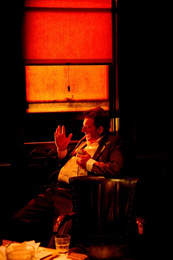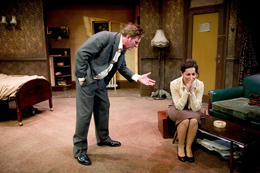Brendan at the Chelsea is the opening production at the Naughton Studio, the second performance space at the newly refurbished Lyric Theatre. The space is intended to host productions of new writing, intimate classics, and work in development, so it is perhaps fitting that its first show should be a recent (2008) piece of writing about Brendan Behan, so influential a figure in Irish literature and theatre. The work draws upon the wit and character of Behan’s writing to imagine his time at the legendary Chelsea Hotel in New York in the early 1960s, working on his commissioned travelogue, Brendan Behan’s New York. Set entirely within the hotel  suite, the plot focuses on the birth of his son by his girlfriend, his brief and abortive attempt to leave his wife Beatrice, and the deterioration of his health caused by his drinking – he was to die the following year at the age of 41. Behan is ably played by Adrian Dunbar, who first performed the role in the premiere production in 2008 at the Riverside Studios in London. Dunbar also directs, with Pauline Hutton as Beatrice and the other three performers sharing a range of roles.
suite, the plot focuses on the birth of his son by his girlfriend, his brief and abortive attempt to leave his wife Beatrice, and the deterioration of his health caused by his drinking – he was to die the following year at the age of 41. Behan is ably played by Adrian Dunbar, who first performed the role in the premiere production in 2008 at the Riverside Studios in London. Dunbar also directs, with Pauline Hutton as Beatrice and the other three performers sharing a range of roles.
Behan’s stature as a writer is inextricable from his popular construction as tortured artist and stage Irishman, making it difficult to separate him from well-known theatrical stereotypes. In this portrayal, the author balances the genial, singing, drunken, witty “broth of a boy” against a clumsy flirtation with the young dancer who helps care for him, and a vicious verbal assault on his wife. Structurally, the piece expresses Behan’s increasing confusion as his mental state deteriorates into alcoholic nightmares and his sense of time and place become confused. This sense of confusion is facilitated by Stuart Marshall’s set design, in which concealed exits allow these imagined or remembered characters to enter and exit, seemingly through the walls.
 The casting enhances the portrayal of Behan’s increasing disconnectedness from reality, by having the actors play multiple roles. Renee Castle, Richard Orr and Chris Robinson play the dancer Lianne, Behan’s friend George and his agent Don respectively, in the moment of Behan's 'reality'; but they also play medical staff, guests on imaginary holidays and imagined sexual partners in his hallucinations. Oddly, the detailed naturalism of the set – it is a representation of a hotel suite – which should be at odds with the expressionism of the play, works by giving the audience an affective sense of the central character’s confusion. The hallway of the suite becomes the hotel elevator and a dance floor at a hotel, without warning. This clash of the two fictional spaces gives the audience a glimpse into Behan’s alcoholic hallucination. Overall, the play is a witty piece of writing and the show was well-attended and well-received.
The casting enhances the portrayal of Behan’s increasing disconnectedness from reality, by having the actors play multiple roles. Renee Castle, Richard Orr and Chris Robinson play the dancer Lianne, Behan’s friend George and his agent Don respectively, in the moment of Behan's 'reality'; but they also play medical staff, guests on imaginary holidays and imagined sexual partners in his hallucinations. Oddly, the detailed naturalism of the set – it is a representation of a hotel suite – which should be at odds with the expressionism of the play, works by giving the audience an affective sense of the central character’s confusion. The hallway of the suite becomes the hotel elevator and a dance floor at a hotel, without warning. This clash of the two fictional spaces gives the audience a glimpse into Behan’s alcoholic hallucination. Overall, the play is a witty piece of writing and the show was well-attended and well-received.
It will be interesting to see how the use of this Studio evolves in the coming years, possibly by offering opportunities to explore performance aesthetics and contemporary writing from different parts of the world, in a space that can be subsidised by the mainstage and that, crucially, has access to the technical capabilities of a large theatre.
Lisa Fitzpatrick lectures in Drama at the University of Ulster.